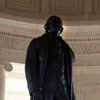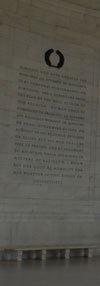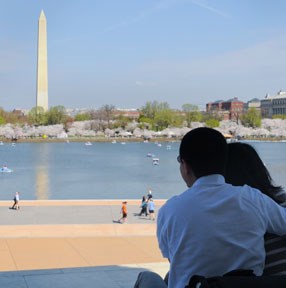|
The Building: Exterior 
NPSPhoto.
The Jefferson Memorial building is a circular, open-air structure featuring a shallow dome supported by a circular colonnade composed of 26 Ionic columns. An additional 12 columns support the north portico, and 4 columns stand in each of the memorials 4 openings. The memorial is constructed of white Imperial Danby marble from Vermont and it rests upon a series of granite and marble-stepped terraces. A flight of granite and marble stairs and platforms, flanked by granite buttresses, lead up from the Tidal Basin. The stairs rise to a portico with a triangular pediment, which features a sculpture by Adolph A. Weinman, depicting the five members of the drafting committee of the Declaration of Independence submitting their report to Congress. A dentiled cornice with an egg and dart molding surrounds the pediment, below which is a plain frieze.
The Building: Interior 
The Jefferson Memorial interior is constructed of white Georgia marble with an axed finish, and the floor is made of pink Tennessee marble. The interior freize is topped by a dentiled cornice and a massive Indiana limestone dome. The dome's interior is divided into two parts: the lower section has a coffered surface containing lights that illuminate the statue and the upper section has a smooth, uninterrupted surface. 
The Statue: 
Quotations: The northwest wall is inscribed with a combination of six quotations taken primarily from Jefferson's "1786 Notes of Virginia" and "Summary Views," which illustrate his beliefs in the evils of slavery and the need to educate the masses. The northeast wall contains a quote from the "Act of Religious Freedom," which was adopted in 1779 and eliminated the state church of Virginia; this quote expresses Jefferson's views on freedom of religion. A fifth quote is engraved on the freize encircling the memorial's interior. This quote "I have sworn upon the altar of God eternal hostility against every form of tyranny over the mind of man," is taken from an 1800 letter from Jefferson to Benjamin Rush.
The Memorial Landscape 
The Jefferson Memorial sits on the south side of the Tidal Basin on reclaimed land created during the construction of Hains Point. After reclamation and before the memorial was built, the area of newly created parkland was planted with trees and lawn. This area was often use for swimming by city residents. Japanese cherry trees were planted on the site in 1912 when the Mayor of Tokyo presented three thousand trees to the city. 
Views and Vistas At the time of construction, much thought was also given to the relationship between the Lincoln and Jefferson Memorials. Additional tree pruning was completed to ensure a narrow view from one memorial to the other. |
Last updated: March 29, 2021
